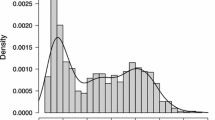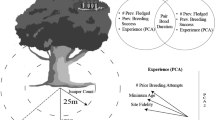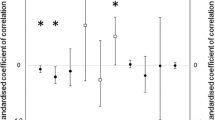Abstract
Predatory species’ usage of different prey types is affected by both prey availability and selectivity. The diet during the breeding season may affect the reproductive success of individual pairs. We studied the prey use of a small reversed size-dimorphic raptor, the Eurasian sparrowhawk Accipiter nisus, with respect to prey weight on two organizational levels. Using 13 years of data from southern Norway, we related reproductive output of individual breeding events to prey size taken. Further, we assessed the regional variation in prey usage between five Fennoscandian populations. This was done by fitting optimum-type functions to the prey species’ numbers or relative predation risks. Pairs that successfully completed the season with more fledglings displayed less variation in prey size, suggesting a possible adaptive benefit of diet specialism, or possibly a correlative effect due to higher prey availability or lower female hunting effort. This finding contrasts with earlier raptor studies, which have suggested benefits of dietary (and hence nutritional) diversity. Indeed, our results might be limited to nutritionally substitutable prey items. We also found a tendency suggesting that older females raised more fledglings than 1-year-old females. In the population-level analysis, we found that optimum-type functions with constant width and spatially variable average best described the relationship between relative predation risk and log weight. This can reflect local conditions, such as prey availability. Our findings and new methodological tools could apply to a broader spectrum of predators. They also highlight the role of viewing usage or choice of prey at several spatial scales.



Similar content being viewed by others
References
Andersson M, Norberg RÅ (1981) Evolution of the reversed sexual size dimorphism and role partitioning among predatory birds, with a size scaling of flight performance. Biol J Linn Soc 15:105–130. doi:10.1111/j.1095-8312.1981.tb00752.x
Angelstam P, Lindström E, Widén P (1984) Role of predation in short-term population fluctuations of some birds and mammals in Fennoscandia. Oecologia 62:199–208. doi:10.1007/BF00379014
Araújo MS, Bolnick DI, Layman CA (2011) The ecological causes of individual specialisation. Ecol Lett 14:948–958. doi:10.1111/j.1461-0248.2011.01662.x
Arnold TW (2010) Uninformative parameters and model selection using Akaike’s information criterion. J Wildl Manage 74:1175–1178. doi:10.2193/2009-367
Ashton KG (2002) Patterns of within-species body size variation of birds: strong evidence for Bergmann’s rule. Global Ecol Biogeogr 11:505–523. doi:10.1046/j.1466-822X.2002.00313.x
Bates D, Maechler M, Bolker B, Walker S (2013) lme4: linear mixed-effects models using Eigen and S4. R package version 1.0-5. http://CRAN.R-project.org/package=lme4/
Begon M, Townsend CR, Harper JL (2006) Ecology: from individuals to ecosystems, 4th edn. Blackwell, London
Bergmann C (1847) Über die Verhältnisse der Wärmeökonomie der Thiere zu ihrer Grösse. Gött Stud 3:595–708
Bolnick DI, Svanbäck R, Fordyce JA, Yang LH, Davis JM, Hulsey CD, Forister ML (2003) The ecology of individuals: incidence and implications of individual specialization. Am Nat 161:1–28. doi:10.1086/343878
Byholm P, Rousi H, Sole I (2011) Parental care in nesting hawks: breeding experience and food availability influence the outcome. Behav Ecol 22:609–615. doi:10.1093/beheco/arr019
Christensen RHB (2013) ordinal: regression models for ordinal data. R package version 2013.9-30 http://www.cran.r-project.org/package=ordinal/
Devictor V, Clavel J, Julliard R, Lavergne S, Mouillot D, Thuiller W, Venail P, Villéger S, Mouquet N (2010) Defining and measuring ecological specialization. J Appl Ecol 47:15–25. doi:10.1111/j.1365-2664.2009.01744.x
Dunning JB Jr (ed) (2006) CRC handbook of avian body masses. CRC, London
Eldegard K, Selås V, Sonerud GA, Steel C, Rafoss T (2003) The effect of parent sex on prey deliveries to fledgling Eurasian sparrowhawks Accipiter nisus. Ibis 145:667–672. doi:10.1046/j.1474-919X.2003.00229.x
Espie RH, Oliphant LW, James PC, Warkentin IG, Lieske DJ (2000) Age-dependent breeding performance in merlins (Falco columbarius). Ecology 81:3404–3415. doi:10.1890/0012-9658(2000)081[3404:ADBPIM]2.0.CO;2
Frumkin R (1994) Intraspecific brood-parasitism and dispersal in fledgling sparrowhawks Accipiter nisus. Ibis 136:426–433. doi:10.1111/j.1474-919X.1994.tb01117.x
Futuyma DJ, Moreno G (1988) The evolution of ecological specialization. Annu Rev Ecol Syst 19:207–233
Geer T (1981) Factors affecting the delivery of prey to nestling sparrowhawks (Accipiter nisus). J Zool 195:71–80. doi:10.1111/j.1469-7998.1981.tb01894.x
Götmark F, Post P (1996) Prey selection by sparrowhawks, Accipiter nisus: relative predation risk for breeding passerine birds in relation to their size, ecology and behaviour. Phil Trans R Soc Lond B 351:1559–1577. doi:10.1098/rstb.1996.0141
Huhta E, Rytkönen S, Solonen T (2003) Plumage brightness of prey increases predation risk: an among-species comparison. Ecology 84:1793–1799. doi:10.1890/0012-9658(2003)084[1793:PBOPIP]2.0.CO;2
Hutchinson GE (1957) Concluding remarks. Cold Spring Harbor Symp Quant Biol 22:415–427
Katzner TE, Bragin EA, Knick ST, Smith AT (2005) Relationship between demographics and diet specificity of imperial eagles Aquila heliaca in Kazakhstan. Ibis 147:576–586. doi:10.1111/j.1474-919X.2005.00443.x
Kottek M, Grieser J, Beck C, Rudolf B, Rubel F (2006) World map of the Koppen-Geiger climate classification updated. Meteorol Z 15:259–263. doi:10.1127/0941-2948/2006/0130
Lehikoinen A (2011) Advanced autumn migration of sparrowhawk has increased the predation risk of long-distance migrants in Finland. PLoS One 6:e20001. doi:10.1371/journal.pone.0020001
MacArthur RH (1972) Geographical ecology. Harper & Row, New York
Margalida A (2008) Bearded vultures (Gypaetus barbatus) prefer fatty bones. Behav Ecol Sociobiol 63:187–193. doi:10.1007/s00265-008-0649-6
Margalida A, Bertran J, Heredia R (2009) Diet and food preferences of the endangered bearded vulture Gypaetus barbatus: a basis for their conservation. Ibis 151:235–243. doi:10.1111/j.1474-919x.2008.00904.x
Meiri S, Dayan T (2003) On the validity of Bergmann’s rule. J Biogeogr 30:331–351. doi:10.1046/j.1365-2699.2003.00837.x
Mikkola H, Tornberg R (2014) Sex-specific diet analysis of the Eurasian eagle owl in Finland. Ornis Fenn 91:195–200
Møller AP, Nielsen JT, Garamzegi LZ (2008) Risk taking by singing males. Behav Ecol 19:41–53. doi:10.1093/beheco/arm098
Møller AP, Solonen T, Byholm P, Huhta E, Nielsen JT, Tornberg R (2012) Spatial consistency in susceptibility of prey species to predation by two Accipiter hawks. J Avian Biol 43:390–396. doi:10.1111/j.1600-048X.2012.05723.x
Moss D (1976) Woodland song-bird populations and growth of nestling sparrowhawks. PhD thesis, University of Edinburgh
Navarro-López J, Vergara P, Fargallo JA (2014) Trophic niche width, offspring condition and immunity in a raptor species. Oecologia 174:1215–1224. doi:10.1007/s00442-013-2855-9
Newton I (1978) Feeding and development of sparrowhawk Accipiter nisus nestlings. J Zool 184:465–487. doi:10.1111/j.1469-7998.1978.tb03302.x
Newton I (1979) Population ecology of raptors. Poyser, London
Newton I (1986) The sparrowhawk. Poyser, Calton
Nielsen JT (2005) Age-specific production of young and lifetime reproductive success of sparrowhawks in Vendsyssel, northern Denmark (in Danish with English summary). Dansk Orn Foren Tidsskr 99:209–217
Olson VA, Davies RG, Orme CDL, Thomas GH, Meiri S, Blackburn TM, Bennett PM (2009) Global biogeography and ecology of body size in birds. Ecol Lett 12:249–259. doi:10.1111/j.1461-0248.2009.01281.x
Opdam P (1978) Feeding ecology of a Sparrowhawk population (Accipiter nisus). Ardea 66:137–155
Orians GH, Pearson NE (1979) On the theory of central place foraging. In: Horn J, Stairs GR, Mitchell RD (eds) Analysis of ecological system. Ohio State University Press, Columbus, pp 155–177
Perrins CM, Geer TA (1980) The effect of sparrowhawks on tit populations. Ardea 68:133–142
Perrins CM, McCleery RH (1985) The effect of age and pair bond on the breeding success of great tits Parus major. Ibis 127:306–315
Perrins CM, Moss D (1974) Survival of young great tits in relation to age of female parent. Ibis 116:220–224. doi:10.1111/j.1474-919X.1974.tb00242.x
Pyle P, Spear LB, Sydeman WJ, Ainley DG (1991) The effects of experience and age on the breeding performance of western gulls. Auk 108:25–33
Risch M, Brinkhof MWG (2002) Sex ratios of sparrowhawk (Accipiter nisus) broods; the importance of age in males. Ornis Fenn 79:49–59
Rosenzweig ML (1981) A theory of habitat selection. Ecology 62:327–335. doi:10.2307/1936707
Rytkönen S, Kuokkanen P, Hukkanen M, Huhtala K (1998) Prey selection by sparrowhawks Accipiter nisus and characteristics of vulnerable prey. Ornis Fenn 75:77–87
Schoener TW (1971) Theory of feeding strategies. Annu Rev Ecol Syst 2:369–404
Selås V (1993) Selection of avian prey by breeding sparrowhawks Accipiter nisus in southern Norway: the importance of size and foraging behaviour of prey. Ornis Fenn 70:144–154
Slagsvold T, Sonerud GA (2007) Prey size and ingestion rate in raptors: importance for sex roles and reversed sexual size dimorphism. J Avian Biol 38:650–661. doi:10.1111/j.2007.0908-8857.04022.x
Solonen T (1997) Effect of sparrowhawk Accipiter nisus predation on forest birds in southern Finland. Ornis Fenn 74:1–14
Solonen T (2000) Predation by sparrowhawks Accipiter nisus and vulnerability of prey. Ornis Fenn 77:27–37
Sulkava P (1964) On the behaviour and food habits of the sparrowhawk (Accipiter nisus) during the nesting season (in Finnish with English summary). Suomen Riista 17:93–105
Whitfield DP, Reid R, Haworth PF, Madders M, Marquiss M, Tingay R, Fielding AH (2009) Diet specificity is not associated with increased reproductive performance of Golden Eagles Aquila chrysaetos in Western Scotland. Ibis 151:255–264. doi:10.1111/j.1474-919X.2009.00924.x
Wyllie I, Newton I (1994) Latitudinal variation in the body-size of sparrowhawks Accipiter nisus within Britain. Ibis 136:434–440. doi:10.1111/j.1474-919X.1994.tb01118.x
Acknowledgments
We thank Tore Slagsvold for inspiring discussions on the subject and for comments on the manuscript. We are grateful to Patrik Byholm, two anonymous reviewers and the editors for their comments, which significantly improved our manuscript. Finally, we thank Aubrey Jane Roberts who improved the English language in the final version of the manuscript.
Author information
Authors and Affiliations
Corresponding author
Additional information
Communicated by Chris Whelan.
A. Otterbeck and A. Lindén contributed equally to this work.
Electronic supplementary material
Below is the link to the electronic supplementary material.
Rights and permissions
About this article
Cite this article
Otterbeck, A., Lindén, A. & Roualet, É. Advantage of specialism: reproductive output is related to prey choice in a small raptor. Oecologia 179, 129–137 (2015). https://doi.org/10.1007/s00442-015-3320-8
Received:
Accepted:
Published:
Issue Date:
DOI: https://doi.org/10.1007/s00442-015-3320-8




